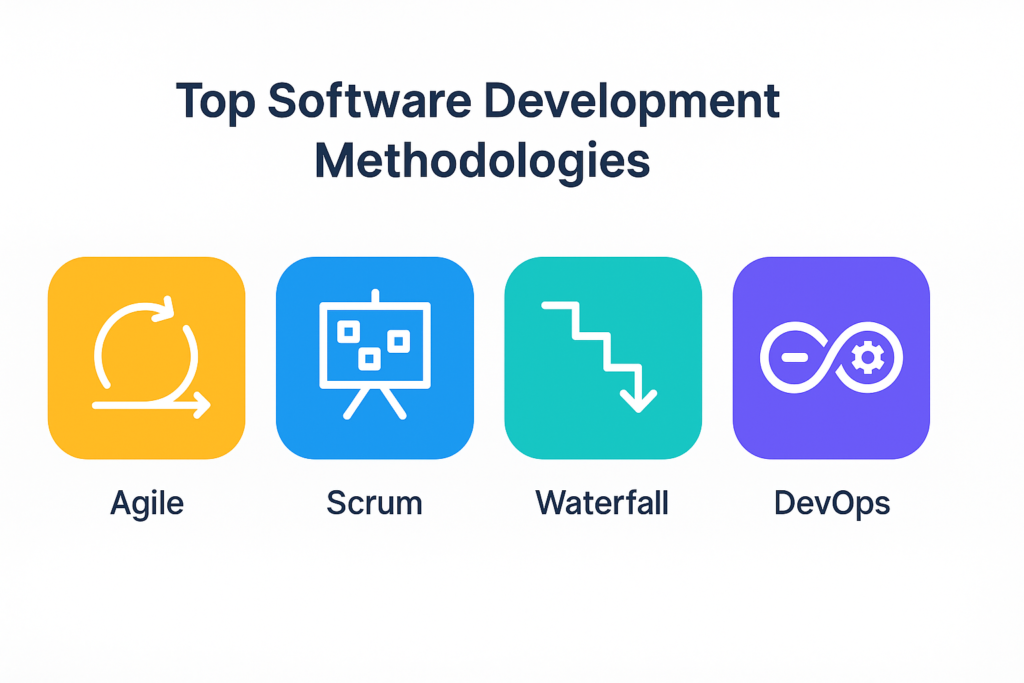In the fast-paced world of software development, choosing the right methodology can make or break a project. In 2025, technological evolution, shifting market demands, and remote collaboration tools have reshaped how software teams operate. Whether you’re building a mobile app, enterprise software, or a scalable web platform, understanding the latest development methodologies is essential.
As a leading Software Development Company in Australia, we’ve witnessed firsthand how adopting the right methodology helps deliver quality products faster, increase client satisfaction, and reduce project risks. In this blog, we’ll explore the top software development methodologies dominating 2025 and help you decide which one is best suited for your project.
Why Development Methodologies Matter
A software development methodology is a structured approach that guides how teams plan, execute, and deliver software. It defines workflows, roles, timelines, and feedback loops. The right methodology ensures:
- Improved communication and collaboration
- Early identification of issues
- Faster delivery and adaptability
- Higher quality and customer satisfaction
With many options available today, choosing a methodology depends on your project type, team structure, timeline, and goals.
1. Agile Development: Still the Leader in 2025
Agile remains the most popular and adaptable methodology in 2025. Known for its flexibility, Agile focuses on iterative development, customer feedback, and rapid delivery.
Key Features:
- Short sprints (usually 1–4 weeks)
- Continuous feedback and iteration
- Daily stand-ups and sprint reviews
- Close collaboration between cross-functional teams
Agile is ideal for startups, mobile app development, and projects with evolving requirements.
Pro Tip from a Software Development Company in Australia: Agile is best when you’re not entirely sure about the final product features at the beginning. It allows scope for evolution.
2. Scrum: A Powerful Agile Framework
Scrum is one of the most widely adopted Agile frameworks, especially in teams that require structure within flexibility. It breaks work into small, manageable sprints and includes roles like Product Owner, Scrum Master, and Development Team.
Why Use Scrum in 2025?
- Better transparency and ownership
- Rapid progress tracking with sprint boards
- Frequent stakeholder engagement
Scrum is suitable for small to mid-sized development teams and is commonly used in SaaS, mobile apps, and e-commerce platforms.
3. DevOps: Where Development Meets Operations
DevOps has evolved into more than just a buzzword—it’s a movement. In 2025, DevOps is essential for teams focused on automation, continuous integration/continuous deployment (CI/CD), and improving collaboration between development and IT operations.
Benefits of DevOps:
- Faster and more reliable software releases
- Automated testing and deployment pipelines
- Enhanced security and infrastructure management
DevOps is an excellent fit for enterprise projects, cloud-based platforms, and companies focusing on microservices architecture.
4. Waterfall: Traditional but Still Relevant
Waterfall is a linear and sequential methodology where each phase must be completed before the next begins. Despite being one of the oldest models, it’s still relevant in specific use cases in 2025.
Best For:
- Government projects
- Banking and finance systems
- Projects with clearly defined requirements
A trusted Software Development Company in Australia may still recommend Waterfall for projects that need detailed documentation, strict compliance, and minimal changes during execution.
5. Lean Software Development
Derived from lean manufacturing principles, Lean development emphasizes minimizing waste, improving efficiency, and delivering only what is necessary. It encourages developers to focus on customer value and eliminate anything that doesn’t contribute to it.
Core Principles:
- Eliminate waste
- Amplify learning
- Deliver fast
- Build integrity in
- Empower the team
Lean is suitable for MVP (Minimum Viable Product) development and startup ecosystems.
6. Kanban: Visual and Flow-Based
Kanban focuses on visualizing tasks and managing workflow. It allows teams to see the status of tasks in real time, using boards with columns like “To Do,” “In Progress,” and “Done.”
Key Advantages:
- Continuous delivery
- Flexibility in task management
- Visual workflow tracking
Perfect for marketing software, customer support platforms, and evolving projects that need high visibility and less rigid planning.
7. Rapid Application Development (RAD)
RAD emphasizes rapid prototyping over long, drawn-out development cycles. It involves quick iterations, frequent user feedback, and modular development.
Ideal Use Cases:
- Projects with tight deadlines
- Internal business apps
- Proof-of-concept builds
In 2025, RAD is enhanced by modern low-code/no-code platforms and AI-driven design tools.
8. Extreme Programming (XP)
XP is another Agile-based approach but with an added focus on software engineering practices like pair programming, test-driven development (TDD), and continuous integration.
Great For:
- Projects requiring high-quality code
- Fintech and health tech apps
- Teams that value robust testing
Though niche, XP is gaining traction in regulated industries and high-reliability systems in 2025.
9. Feature-Driven Development (FDD)
FDD organizes development around building specific features. It includes planning, designing, and building feature sets based on client priorities.
Benefits:
- Efficient for larger teams
- Focused and modular
- Easy to track project progress
Used by many large enterprise teams, FDD helps scale Agile methodologies.
10. Hybrid Methodologies
In 2025, many companies are blending methodologies to suit unique project needs. For example, a business might use Agile for the frontend and Waterfall for backend systems.
As a seasoned Software Development Company in Australia, we often implement hybrid models for clients who require the agility of Scrum with the predictability of Waterfall. These custom models offer the best of both worlds.
Final Thoughts
2025 has brought exciting changes to software development practices. From Agile and DevOps to hybrid and AI-driven models, there’s a methodology suited for every project.
Choosing the right one can streamline your development lifecycle, improve code quality, and lead to better user experiences. Partnering with an experienced Software Development Company in Australia ensures you don’t just adopt a methodology but optimize it for real business value.

